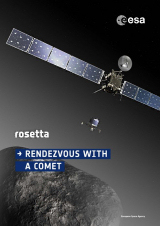ESA Science & Technology - Publication Archive
Publication archive
Publication archive
[Remainder of abstract truncated due to character limitations]
Press kit for the 6 August 2014 press event marking the arrival of Rosetta at comet 67P/Churyumov-Gerasimenko.
Contents:
Media services
Rosetta arrives at comet 67P/ Churyumov-Gerasimenko
Quick reference mission facts
Highlights from the Rosetta mission thus far
How Rosetta arrives at and orbits comet 67P/C-G
Selecting a Landing Site for Rosetta’s lander, Philae
Landing on a Comet
Comets – an introduction
Rosetta's comet – at a glance
Missions to comets - Rosetta in context
Appendix A: Draft programme for press event
Appendix B: Speakers at the 6 August press event
Appendix C: Selected Rosetta images & videos
Appendix D: Mission timeline for August to November
Appendix E: Distances, dates, times for mission milestones
An earlier version of the press kit contained an error on page 12: the paragraph on the provision of the lander should read: Rosetta's Philae lander is provided by a consortium led by DLR, MPS, CNES and ASI.
 |
Rosetta is ESA's comet-chasing mission to 67P/Churyumov-Gerasimenko. Launched on 2 March 2004, the spacecraft travelled for 10 years and required three gravity-assist flybys at Earth and one at Mars before homing in on its target.
Comets are considered to be the most primitive building blocks of our cosmic neighbourhood, surviving the Solar System's chaotic 4.6 billion-year history more or less intact. Laced with ice and organic materials, comets likely helped to 'seed' Earth with water, and perhaps even the ingredients for life. By studying one of these icy treasure chests in great detail, ESA's Rosetta is set to unlock the secrets of the Solar System.
Table of contents:
- Rosetta: Europe's comet-chaser
- The long trek
- Fleeting flybys of battered worlds
- Hot and cold
- What do we know about comet 67P/Churyumov-Gerasimenko?
- Rendezvous with a comet
- Landing on a comet
- The Rosetta orbiter
- The Philae lander
- Escorting a comet
- Long-distance communications
- An international enterprise
- Join the adventure
Note: a more recent Rosetta mission brochure (ESA BR-321) is available here.
This document presents the results of the CDF study performed in 2014, that analysed the feasibility of a joint ESA-ROSCOSMOS Phobos sample return mission. It was performed by an interdisciplinary team composed of specialists from ESA, IKI (RU) and Lavochkin (RU).
--- Remainder of abstract truncated due to character limitations ---
